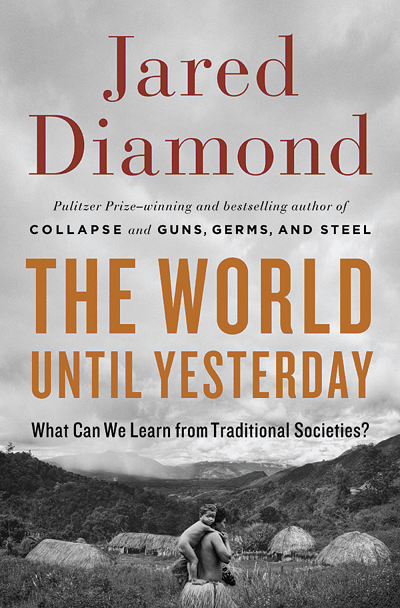By RASHA MADKOUR
Associated Press
What if, in trying to figure out the best way to lead our lives, we could conduct tests on the different methods?
According to author Jared Diamond, such trials are already taking place. In his new book, “The World Until Yesterday,” Diamond argues: “Traditional societies in effect represent thousands of natural experiments in how to construct a human society. They have come up with thousands of solutions to human problems” — solutions, he points out, that are different from those adopted by modern, industrialized societies.
Diamond, who wrote the Pulitzer Prize-winning “Guns, Germs, and Steel” and is a geography professor at UCLA, warns against romanticizing and idealizing the past, while encouraging readers to consider that some traditional practices may be a better fit for us. What follows is an extensive, textbooklike examination of issues ranging from conflict resolution to treatment of the elderly, language diversity to salt intake.
In a striking anecdote early on, Diamond relates the story of a New Guinean boy who was killed after darting in front of a minibus. Through time-honored traditions, the driver (and his company) paid the boy’s family “sorry money” and participated in a “say-sorry” ceremony. Both sides took time to talk — the driver’s boss said the food and money they were bringing were nothing compared with the life of the child; the boy’s father acknowledged the death was an accident. They then shared a meal together and shook hands at the end.
Diamond contrasts this to the civil lawsuit and criminal charges that would likely be brought in the United States.
Allo-parenting — where a child’s regular caregivers extend beyond just the parents — is another area where tradition appears to trump modern practices, Diamond says. Grandparents, aunts, uncles, other adults and older siblings play pivotal roles in caring for children, providing diverse influences and sharing in the responsibility. Anthropologists are often struck by the “precocious development of social skills among children in those societies,” Diamond says, “and they speculate that the richness of allo-parental relationships may provide part of the explanation.”
Traditional practices can offer indirect lessons, too. Investors would be wise to take cues from the practices of Andean farmers, Diamond says. Their scattered plots were deemed by outsiders “appalling” in their inefficiency, yet the farmers’ goals weren’t to maximize time-averaged yields. What good are nine productive years if the tenth year has no yield, putting them at risk of starvation? Their goal, then, was to make sure yields never drop below a certain level. The diffuse plots account for variation and unpredictability in crop yield from field to field, year to year, Diamond writes. In the same vein, if you’re depending on your investments to pay current expenses, you need to settle for a lower yield in exchange for more security and stability.
The book is liberally peppered with personal anecdotes from Diamond’s various expeditions. He recounts one memorable incident where his New Guinean companions refused to sleep near a tall dead tree for fear it would fall and kill them. Diamond thought they were being absurd. But as months of forest camping went by, he realized that he heard a tree falling almost every day. As such, if New Guineans spend much of their lives camping, it behooves them to take precautions with repeated low-risk activities because the hazard is cumulative. The same can be said in modern societies with driving a car, Diamond argues.
While there is no shortage of thought-provoking material in the book, it’s unclear whether a casual reader would have the patience to slog through some of the more mundane, drawn-out sections.
Still, Diamond’s style is a model of explanatory writing, and he delivers on his premise that the past is worth revisiting.
Send questions/comments to the editors.



Comments are no longer available on this story